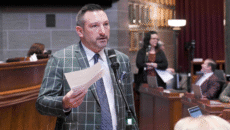“You’re living in poverty, your schools are no good, you have no jobs, 58 percent of your youth is unemployed — what the hell do you have to lose?” – Donald Trump, then Presidential Candidate and Real Estate Mogul, Aug. 19, 2016
Quite a bit, according to history.
I am a parent and a teacher. I work in St. Louis City and my child goes to school in the suburbs. This gives me a unique perspective on how different people view the world. The disparity between the city and some suburbs is astonishing. I try to listen more and judge less. During my tenure teaching students from around the world and from the city, I have learned a lot about St. Louis. I am not reassured by what I’ve learned.
Travelling uneasily between parallel universes comprising home and work, I worry about the future. Blatant segregation permeates the metropolitan area, dividing people as if in foreign countries. Segregation has historically been defined in two ways: de jure, meaning legally mandated or de facto, meaning voluntary.
Technically, with the end of Jim Crow, St. Louis is de facto segregated. Perhaps. But is that accurate? The fact that our segregation clearly serves one group over another in 2017 troubles me deeply. How is it possible that in the 21st century people don’t have a sense of urgency about segregation? Do other people recognize that this is a problem?
Data reveals that, even in cases of equal income, white borrowers are more likely to receive a loan for a home mortgage than black borrowers. The more I research, I see a pattern emerge suggesting that segregation has actually been a long-term infrastructure plan that began nearly one hundred years ago.
In the 1930’s the U.S. Government asked the Home Owners’ Loan Corporation to evaluate the riskiness of mortgages and from there a map of discrimination and racism was created that laid the foundation for the segregation we see today. This map assigned neighborhoods security codes based on mortgage security risk. Archived documents show that much of the criteria were based on race, immigrant status, and socioeconomics. The Civil Rights Movements, the Fair Housing Act, and the work of people who fought for justice for decades couldn’t change the damage that this map had already caused because it based the home property values on the people who lived in those homes.
This map has shaped our perceptions of homes, schools, and crime ever since, whether we realize it or not. It has fed into the perception that there are “good” and “bad” places to live. It also shows how generations of African Americans were denied access to home mortgages based on race between 1930 and 1968. As their white counterparts were purchasing homes and acquiring wealth, black Americans were segregated by “risk assessment analysis.” This happened mostly in secret, even as Jim Crow died in the south. Despite the passage of the Fair Housing Act in 1968, discrimination against people due to race continues in the housing industry. This has impacted African Americans’ equal access to jobs that increasingly moved to the suburbs since the 1970’s.
Since then, the conversation has shifted to “good” and “bad” schools. Public education has always been tied to property value. Schools located in areas with higher property tax revenues receive more resources. The opposite is true in poor areas. Schools with more resources, tend to have students that perform better on tests. Test scores have become the not so coded language to describe “good” and “bad” schools. Thus, the endless cycle of “bad” neighborhoods equal “bad” schools and the associations with race has become cemented in the American mindset. “Bad” schools get punished for low test scores by receiving even less resources and the students lose, as does the community.
Segregation is reprehensible, whether it is de jure or de facto. It echoes a shameful part of American history. Any American citizen who lives under these apartheid-like conditions suffers a great injustice and we are all harmed by it. As Americans, we should feel a duty to correct the wrongs of our past. I am hoping that Alderman John Collins-Muhammed and the Black Caucus pass the resolution for reparations that calls for the city to acknowledge its role in the history of slavery and to commit to studying how the effects of slavery have contributed to crime and poverty. If the resolution doesn’t pass, we should all be concerned that St. Louis is not ready to face the lasting consequences of our history.
Kathleen Ross is an educator from Ballwin and holds an Educational Specialist Degree for Educational Leadership from Webster University.








